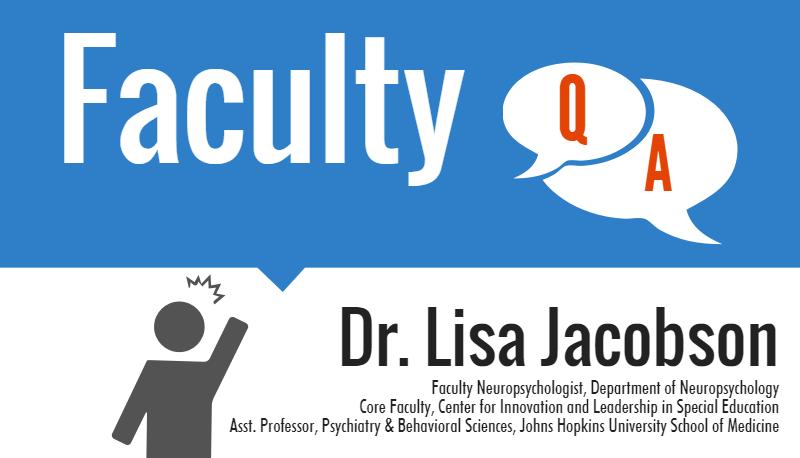By Lisa Carey
July 31, 2018

LC: You have training as both a school psychologist and a pediatric neuropsychologist, so you have a pretty good grasp of the research out there about the impact individual teachers have on student outcomes. What do you think is the biggest take-away from that area of research?
LJ: At the risk of sounding trite, the biggest take away is that teachers have a really substantial impact on students –even well after their students move on to other grades. Every teacher should feel both empowered and challenged by this finding: empowered because the effects of their work are measurable and long-lasting, and challenged because the literature shows that student outcomes are so closely tied to the quality of their teachers. Evaluation of teacher quality should not be thought of as solely a function of administrators marking a checklist. Teaching well really matters!
LC: What does the literature say about what constitutes good teaching?
LJ: The findings from some of the early and on-going work on this topic suggests that having teachers of lower quality has a clear, sizeable, and negative impact on student outcomes years later, especially when students experience multiple grades with lower quality teaching. These findings prompted many studies seeking to understand what makes “good teaching” work so well and how to measure the differences between great teaching and not-so-great teaching.
Work in this area has shown that a critical component is the quality of the interactions between teachers and their students; an adequate teacher can follow the curriculum, modify materials as needed and answer students’ questions to regarding curricular content, but a very high quality teacher does all of this while providing warmth and empathy, structuring the classroom and its routines in a way that maximizes instructional time and provides security to students and simultaneously provides high quality instructional feedback and in-time supports that maximize students’ ability to understand new concepts and solve problems (Allen et al., 2013; Cadima et al., 2010; Hamre & Pianta, 2005; Mashburn et al., 2008).
LC: As the Co-Director of the Center for Innovation and Leadership in Special Education, you have a large role providing additional training to experienced teachers, how has the literature in this area impacted your approach to training teachers?
LJ: Knowing that great teachers are critical to real student progress, I am so appreciative of the many teachers who strive to learn more and work to improve their own practice after they finish their degree(s). I try to approach the training I do in a way that respects each teacher’s knowledge and skill set, but also recognizes that there is so much that goes into “good teaching”—much of which is not typically taught in undergraduate or even Masters level education programs. Based on the teacher quality literature, I also try to convey that being a “high quality” teacher is not necessarily about your degree, your Praxis score or the facility and materials in your environment. Being the kind of teacher who makes a substantial, positive impact on students is so much more –and knowledge is a first step to changing both the way teachers think about their work and the way they practice. We take a deep look into teacher quality research to pinpoint actionable changes to instruction that will have a lasting impact on student outcomes.
A less positive take-away from the literature that influences my approach to teacher training is that almost all of the studies that have examined impacts of teacher quality on student outcomes show that very few teachers fall into the highest quality bracket (LaParo, Pianta & Stuhlman, 2004). This is frustrating, challenging and inspiring at the same time; teaching is a difficult job with many moving pieces, but it is clear that high-quality teaching is a critical component to student success. Even though students bring their own challenges to learning into the classroom, these factors do not excuse poor quality teaching. In fact, high-quality teaching may have the greatest potential to impact students most at risk for school failure (Hamre & Pianta, 2005) and may have the largest impact upon math scores (Rivers &Sanders, 2002).
I am inspired to work with the teachers enrolled in our CILSE cohorts to help them improve their practice because I know that better teaching matters for student outcomes, but also because the data suggest that professional development can improve teacher quality (Pianta et al., 2008). What you do as a teacher matters, and what we do to support you also matters!
LC: Measuring the impact teachers have on student outcomes is messy business and the ways in which new research on the topic is presented in the news can be confusing or even misleading. What are some considerations teachers should have when reading research on teacher quality either first or second hand?
LJ: I would encourage teachers to consider several things. First, always expect the reporter or article to explicitly cite their source of information (i.e., the study author and publication date, sometimes with the journal name as well). We are interested in empirically-supported facts, not opinion or someone else’s interpretation of data. When the source is clearly cited, go check it out! See for yourself what the researcher actually found –news reports unfortunately do not always accurately reflect the findings of a study.
Second, try to set aside your biases. When I ask the teachers in our CILSE fellowship cohorts to read articles about assessment of teacher quality, their initial reactions are often emotional because of strong feelings on the topic of being evaluated and perhaps negative (and unfortunate) experiences they’ve had with punitive styles of evaluation. However, once we set those aside and spend time thinking critically about the questions of how to define and measure “good teaching,” and how to define and measure the right outcome variables, and what kinds of variables should also be taken into account in the analytic process (i.e., control variables), teachers get very interested in the data and want to know more about what aspects of teaching actually make the most difference in student success. After all, teachers generally choose to teach because they want students to succeed, right? And, just like any other science, it takes lots of tries to figure out what teacher factors matter most, to which students, and delivered in what way at what time!
References:
Allen, J.P., Pianta, R.C., Gregory, A., Mikami, A.Y., Lun, J. (2013). Observations of effective teacher-student interactions in secondary school classrooms: Predicting student achievement wit hteh classroom assessment scoring system-Secondary. School Psychology Review. 42(1), 76-98.
Cadima,j., Leal, T., Burchinal, M. (2010) The quality of teacher-student interactions: Associations with first graders’ academic and behavioral outcomes. Journal of School Psychology. 48(6), 457-482.
Hamre, B.K., Pianta, R.C. (2005) Can instructional and emotional support in the first-grade classroom make a difference or children at risk for school failure? Child Development. 76(5), 949-967.
LaParo, K.M., Pianta, R.C., Stuhlman,M. (2004)The classroom assessment scoring system: Findings from the prekindergarten year. The Elementary School Journal. 104(5), 409-426.
Mashburn, A.J., Pianta, R.C., Hamre,B.K., Downer, J.T., Barbarin, O.A., Burchinal, M., Early,D.M., Howes, C. (2008) Measures of classroom quality in prekindergarten and children’s development of academic, language, and social skills. 79(3), 732-49.
Pianta, R. C., Mashburn, A. J., Downer, J. T., Hamre, B. K., & Justice, L. (2008). Effects of web-mediated professional development resources on teacher–child interactions in pre-kindergarten classrooms. Early childhood research quarterly, 23(4), 431-451.
Rivers, J. C., & Sanders, W. L. (2002). Teacher quality and equity in educational opportunity: Findings and policy implications. Teacher quality, 13-23.















